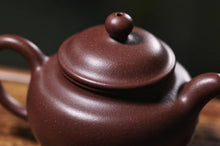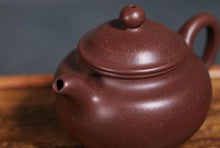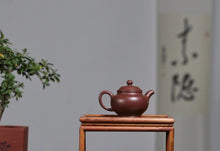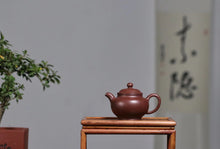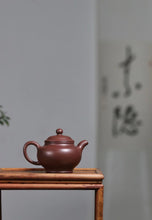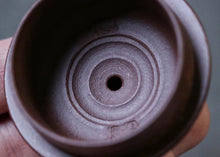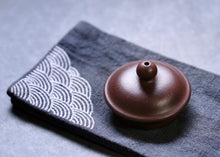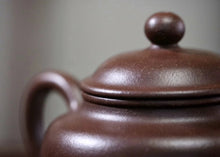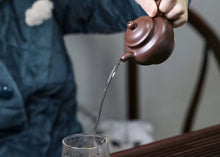
In the long-standing traditional tea culture of China, purple clay pottery is undoubtedly a shining existence. Seasoned tea enthusiasts always consider it a great pleasure to own a purple clay teapot. Thanks to its unique characteristic of "allowing air to pass through while preventing water from seeping through," it can fully bring out the color, aroma, and flavor of the tea, turning every cup of tea into a delightful feast for the taste buds.
The shaping of a purple clay teapot emphasizes the exquisite craftsmanship of hand molding. The artisans carefully scrape and polish it, making the structure of the teapot rigorous and the contour lines distinct, ultimately achieving a smooth, round, and harmonious state. A truly handmade purple clay teapot means that from the selection of the clay material to the final shaping, the whole process is completed by hand without the aid of any molds. Using traditional hand-molding techniques to make a teapot is a great test of the craftsman's skills. Coupled with a long production cycle and a low yield rate, each handmade purple clay teapot is a rare treasure that is hard to come by.
Today, Tongxin She Teahouse is honored to present to all tea lovers a collection-level handmade purple clay teapot - the "Rare Centennial Old Purple Clay Small Duozhi Teapot" made by Master Hui Xiangyun, the 15th generation descendant of Hui Mengchen, with a capacity of 120cc.
Master Hui Xiangyun comes from a family with a long history of pottery making. As the 15th generation descendant of Hui Mengchen, a renowned teapot maker in the Ming Dynasty, he was born in Yixing in 1968. Since his childhood, he has learned the art of teapot making from his father and later studied under Master He Daohong, a renowned Chinese ceramic artist. With a solid foundation in skills and outstanding craftsmanship, he has a profound and unique understanding of purple clay pottery, and is respectfully known as the "Folk Purple Clay Master" by collectors. Mr. Jin Yong once inscribed the words "Hui Xiangyun's Purple Clay Treasures" for him, and Master Qi Gong personally wrote "Xiangyun's Teapot Art Dares to Reach for the Summit." Since the 1990s, concerned about the excessive mining of purple clay resources, Master Hui began to vigorously collect high-quality clay materials, and was jokingly called the "Clay Hoarder" by the industry at that time. His works are impeccable in terms of material selection, design, and production techniques, exquisitely beautiful, and have a high artistic appreciation value and collection value without any trace of shoddy workmanship.
This "Small Duozhi" teapot is made of the rare centennial old purple clay carefully collected by Master Hui Xiangyun. The high quality of the clay material largely determines the extraordinary quality of this teapot. As the saying goes, "Don't boast too soon, sir. First, make a Duozhi and a Hanwa teapot. Compare them in front of the classics, and let the teapot speak for the true craftsmanship." This fully shows the high difficulty of making a Duozhi teapot. This teapot has a well-proportioned body, and although it is small, it does not lack in grandeur. The production process fully demonstrates the master's skills. The curved spout extends gracefully and presses down at the tip, showing a gentle and beautiful posture. The handle of the teapot slightly rises and then slides down elegantly, forming a round and full arc, simple and elegant. The teapot body is plump, with a steady temperament. The spout rises high and tilts, exuding a heroic spirit. The handle is round, and the lid knob is smooth. Beneath its simple and solemn appearance lies a sense of pride. Its charm and taste are close to the realm of grace and elegance.
It is worth mentioning that the centennial old purple clay used in this teapot also has unique suitability for brewing different kinds of tea. The centennial old purple clay has a relatively loose texture, with a distinct dual-pore structure and excellent air permeability, which can effectively absorb the aroma of the tea. It is particularly suitable for brewing oolong tea. For example, in the case of Wuyi rock tea like Dahongpao, the old purple clay can absorb the slight bitterness caused by the roasting of the tea leaves, allowing the original rock and floral fragrance of the rock tea to be fully displayed. The tea soup has a richer layer of flavor and a long-lasting sweet aftertaste. For ripe Pu'er tea, a type of dark tea, the old purple clay teapot can also well interpret its unique flavor, enhancing the richness of the tea soup and making its aged aroma more intense and pure.
For those who love tea culture and are fond of purple clay teapots, this "Rare Centennial Old Purple Clay Small Duozhi Teapot" by Master Hui Xiangyun is undoubtedly a rare collection masterpiece. We look forward to meeting tea lovers who are destined to own it and continuing to write its legend together.


















